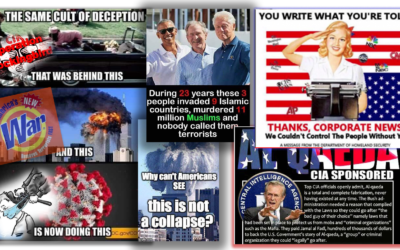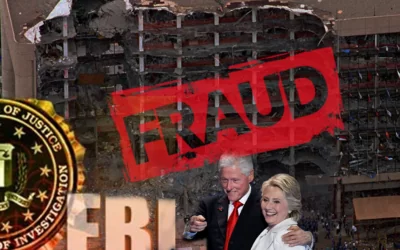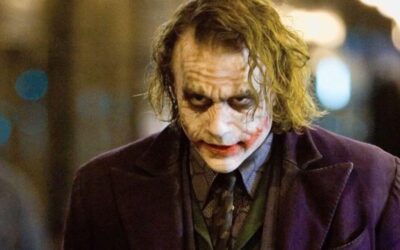by Fenton Bresler Part 1 of 2 [Excerpts]
“Laurel and Hardy, that’s John and Yoko. And we stand a better chance under that guise because all the serious people like Martin Luther King and Kennedy and Gandhi got shot.” John Lennon
Part 1
Bresler begins by questioning the “lone nut” theory. Since 1835, 15 men and 2 women have attacked “nationally prominent political leaders in sixteen separate incidents.” Of those 17, only 3 have been ruled insane by law. Mark David Chapman was never found to be legally insane. “The ‘lone nut’ theory simply does not stand up as an all-embracing explanation covering all — or even most — instances of American political assassination.”
Bresler offers the possibility that “Lennon, the politically most active rock star of his generation… was shot dead outside his own home by a killer who was merely a tool, a human gun used and controlled by others to destroy a uniquely powerful radical figure who was likely to prove a rallying point for mass opposition to the policies soon to be implemented… by the new United States government headed by Ronald Reagan.”
Bresler quotes the late radio journalist Mae Brussell, who broke the Watergate story 2 months before the Woodward-Bernstein expose’. Brussell had no doubts: “It was a conspiracy. Reagan had just won the election. They knew what kind of president he was going to be. There was only one man who could bring out a million people on demonstration in protest at his policies — and that was Lennon.”
Bresler speculates that Chapman was a “Manchurian Candidate,” brainwashed and pre-programmed to kill on command. When the moment had arrived, Chapman received his signal and performed his task.
The CIA and Mind Control
In April 1950, the CIA began work on PROJECT BLUEBIRD, the agency’s fledgling attempt at mind control. “Within two years this had progressed into the substantially enlarged PROJECT ARTICHOKE. According to a later CIA internal memorandum, PROJECT ARTICHOKE was intended to ‘exploit operational lines, scientific methods and knowledge that can be utilized in altering the attitudes, beliefs, thought processes and behaviour patterns of agent personnel. This will include the application of tested psychiatric and psychological techniques including the use of hypnosis in conjunction with drugs.’ In turn, only one year later, in April 1953, PROJECT ARTICHOKE became MKULTRA, the generic name for a series of on-going investigations by the agency’s Technical Services Staff.”
Some might object that pre-programming a subject to be a “killer on command” violates the common wisdom that one cannot be hypnotised to do something that is contray to one’s individual morals. Yet not all “experts” are in agreement on this. For example Milton Kline, a New York psychologist and former president of the American Society for Clinical and Experimental Hypnosis believes it is *not* impossible to create a “Manchurian Candidate.” According to Kline, “It cannot be done by everyone. It cannot be done consistently, but it can be done.”
“There seems little doubt that sophisticated techniques have now reached the stage where, if murder is desired, a killer, once programmed and ‘on hold’, can be triggered into action.”
Sirhan Sirhan
Bresler suggests that Sirhan Sirhan, the supposed lone assassin of Robert F. Kennedy, was a pre-programmed killer. Seven years after the RFK assassination, Sirhan was interviewed by psychiatrists. These recorded interviews were analyzed with the help of a Psychological Stress Evaluator (PSE), a device which measures micro-tremors in the voice. Based on the PSE, former high-ranking intelligence officer Charles McQuiston stated: “I’m convinced that Sirhan wasn’t aware of what he was doing. He was in a hypnotic trance when he pulled the trigger… Everything in the PSE charts tells me that someone else was involved in the assassination — and that Sirhan was programmed through hypnosis to kill RFK. What we have here is a real live ‘Manchurian Candidate.'”
After examining Sirhan’s PSE charts, Dr. John W. Heisse, Jr., president of the International Society of Stress Analysis, agreed with McQuiston: “Sirhan kept repeating certain phrases. This clearly revealed he had been programmed to put himself into a trance.”
Who Killed John Lennon?
by Fenton Bresler Part 2 of 2 [Excerpts]
“Listen, if anything happens to Yoko and me, it was not an accident.”
John Lennon
Part 2
Government Surveillance
During a December, 1971 rally at the University of Michigan (Ann Arbor), undercover FBI agents recorded remarks made by Lennon and others. This is only one case of many, all pointing to a pattern of consistent governmental spying upon Lennon. Under the Freedom of Information Act, Bresler obtained U.S. government files on Lennon. The files show that Lennon was under constant government surveillance, especially during the years 1971-1972.
For example, in an April 10, 1972 memorandum from J. Edgar Hoover to the FBI’s New York office, Hoover orders his agents to “…promptly initiate discrete efforts to locate subject [Lennon] and remain aware of his activities and movements. Handle inquiries only through established sources… Careful attention should be given to reports that subject is heavy narcotics user and any information developed in this regard should be furnished to narcotics authorities and immediately furnished to bureau in form suitable for dissemination.”
“Lennon knew from early in 1972 that he was under constant surveillance, being followed in the streets and with his telephone tapped.” The ex-Beatle was aware of the surveillance by secret police agencies and so stated on several occasions. For example, in December 1975 he told one interviewer, “We knew we were being wire-tapped… there was a helluva lot of guys coming in to fix the phones.”
“Moral Turpitude”
One of the methods used by the U.S. government to harass Lennon was the threat of deportation. The government had extra leverage in its efforts due to a previous conviction against Lennon which charged him with “moral turpitude.” On October 18, 1968, in Britain, Lennon and Ono had been arrested and charged with possession of 1.5 ounces of marijuana. Two weeks before the bust, Lennon had been warned that the police were out to get him because he was a “loudmouth.” As a precaution, he had (as he put it) “cleaned the house out [of drugs].” Nevertheless, marijuana was found in the house by the police. According to Lennon, he had been set up. His opinion is backed up by the fact that the arresting officer was later sentenced to two years in prison for planting evidence in other cases.
In order that Ono would not be charged, Lennon “copped a plea”. Charges against Yoko Ono were dropped and Lennon was fined and found guilty of “an offence of moral turpitude.”
At the time of their arrest, Yoko Ono was pregnant and almost suffered a miscarriage. Although she was immediately hospitalized, a month later she lost the baby. “On being told the end of their child’s unborn life was near, Lennon had a tape recorder brought into the hospital room and, with a stethoscope microphone, he recorded his second son’s failing heartbeats before he died.”
Political Activism
Examples of Lennon’s political activism are seen in songs such as “Give Peace a Chance,” “Power to the People,” and “Working Class Hero.” In an interview published in *Rolling Stone* (and later as a book entitled *Lennon Remembers*), Lennon called the song “Working Class Hero” a “…song for the revolution… It’s for the people like me who are working class.”
In the interview, Lennon further states that “…the people who are in control and in power, and the class system and the whole bullshit bourgeois scene is exactly the same except that there are a lot of middle-class kids with long hair walking around in trendy clothes… The same bastards are in control, the same people are runnin’ everything… They’re doing exactly the same things, selling arms to South Africa, killing blacks on the street, people are living in fucking poverty with rats crawling all over them. It’s the same. It just makes you puke.”
“With Lennon, rock had become revolutionary — and for real. He and Yoko took part in demonstrations, they campaigned for a public inquiry into the case of James Hanratty, convicted of murder and hanged in the early 1960s… they marched for the IRA [Irish Republican Army] and they called for help for striking shipbuilders.”
The Invisible Assassins
Bresler interviewed Arthur O’Connor, the lieutenant who was commanding officer of the twentieth precinct of the New York police that dealt with Lennon’s murder. He quotes O’Connor as saying, “As far as you are trying to build up some kind of conspiracy, I would support you in that line. Like I said originally over the phone, if this gentleman [Chapman] wanted to get away with it, he could have got away with it. There was the subway across the road and no one around to stop him.”
Instead, once Chapman had accomplished his task, he calmly sat and waited for police to come.
“Why one method rather than the other, the amateur as against the professional? Because that way you avoid any awkward questions. If Lennon had been gunned down by a professional killer, the whole world would have known: such swift expert assassinations carry their own individual hallmark. It would have been obvious what had happened and, with Lennon’s history of anti-government radical political activity, there would have been [an in-depth investigation].”
“But if you program an amateur to do the job, a so-called ‘nut’, very few questions are asked.”



